 Each week passes so quickly. We are busy researching, reading, writing and making. We are creating art and models, solving problems and working together. We’re playing and discussing, sharing and reflecting. We have many goals, hopes and dreams – we’re doing our best to achieve all we can.
Each week passes so quickly. We are busy researching, reading, writing and making. We are creating art and models, solving problems and working together. We’re playing and discussing, sharing and reflecting. We have many goals, hopes and dreams – we’re doing our best to achieve all we can.
S.E.L. – Being Aware That We Have Choices
 Trudy Ludwig is an author of many children’s books that explore the social and friendship issues honestly. Each of them shares an unfortunately common social issue – bragging, put down, claims to be kidding, trash talk- and gives a platform to talk about issue without naming names or recapping personal hurts. Further the books offer ways of dealing with the troubling behavior. In each an adult – parent, teacher or counselor- is involved in some way. And in each the child who feels meanness or being made fun of is given some strategies for not taking the words personally. We can each chose how we react. We can hear, “Wow, you’re short!” and feel hurt or we can answer, “Yup, I am.” We can hear, “There were a lot of mistakes over there. (head nod, eye roll)” and feel they’re making fun of me or we can answer, “Yup, but at least I’m trying and learning. How about you?”
Trudy Ludwig is an author of many children’s books that explore the social and friendship issues honestly. Each of them shares an unfortunately common social issue – bragging, put down, claims to be kidding, trash talk- and gives a platform to talk about issue without naming names or recapping personal hurts. Further the books offer ways of dealing with the troubling behavior. In each an adult – parent, teacher or counselor- is involved in some way. And in each the child who feels meanness or being made fun of is given some strategies for not taking the words personally. We can each chose how we react. We can hear, “Wow, you’re short!” and feel hurt or we can answer, “Yup, I am.” We can hear, “There were a lot of mistakes over there. (head nod, eye roll)” and feel they’re making fun of me or we can answer, “Yup, but at least I’m trying and learning. How about you?”
We’ve been trying to spot places where we can react differently to see if we can change how we feel. And we’ve also been trying to support the “trouble talkers” to find different ways to comment. We’ve been noticing when comments fall short of being funny and are actually mean. It’s a process, but we are growing. We are becoming more self-aware and make sure we are doing what is expected and kind. We are trying to cultivate kindness and empathy.
The Power of Punctuation
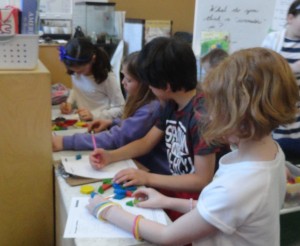 Surprisingly our discussions of how punctuation changes meaning have added to this discussion. Words can have many meanings depending on our tone of voice or the marks we make on paper. We’ve been reading Twenty-Odd Ducks and Eats Shoots and Leaves and also looking at our own writing. It’s interesting to notice when we haven’t written what we though we had. We’ve gotten better at proofreading passages to understand what they mean once punctuation and capitals are added. Happily, I am seeing more attention to this in daily writing.
Surprisingly our discussions of how punctuation changes meaning have added to this discussion. Words can have many meanings depending on our tone of voice or the marks we make on paper. We’ve been reading Twenty-Odd Ducks and Eats Shoots and Leaves and also looking at our own writing. It’s interesting to notice when we haven’t written what we though we had. We’ve gotten better at proofreading passages to understand what they mean once punctuation and capitals are added. Happily, I am seeing more attention to this in daily writing.
Learning About Our Country
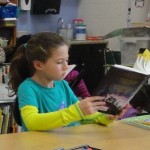
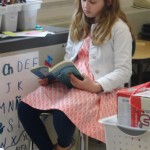 This week we continued our exploration of the United States. This is in preparation for our big parade event in early June. Many of the children have completed reading one or two books about his or her state. They are excitedly exploring images on state symbol websites and are getting excited about what they are learning. Last Friday we sent some of the Parade of States and float information home. Please review this with your child and return the bottom of the blue strip – 5 have returned so far. On Monday we’ll send home a blueprint float planning form. It is our intention that each little step in the process will allow the children to feel proud of their accomplishment. By the time they bring their blueprint form home we hope that most of the children will have a list of at least 5 Wonders from their state that they intend to represent on the float. They may need your help with process to imagine possibilities and to consider what may work.
This week we continued our exploration of the United States. This is in preparation for our big parade event in early June. Many of the children have completed reading one or two books about his or her state. They are excitedly exploring images on state symbol websites and are getting excited about what they are learning. Last Friday we sent some of the Parade of States and float information home. Please review this with your child and return the bottom of the blue strip – 5 have returned so far. On Monday we’ll send home a blueprint float planning form. It is our intention that each little step in the process will allow the children to feel proud of their accomplishment. By the time they bring their blueprint form home we hope that most of the children will have a list of at least 5 Wonders from their state that they intend to represent on the float. They may need your help with process to imagine possibilities and to consider what may work.
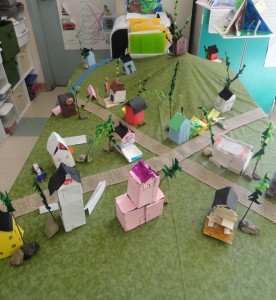
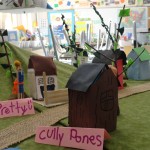
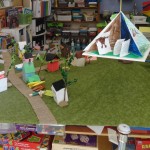 I hope you took time to look at the pictures from years past to consider different options. I’ve put some pictures on the blog for you view as well. We hope that these projects are as much student made as possible. We hope it is a hands-on project for them. Just as Eben searched for Wonders in Sassafras Springs, your child is on the look out for between 5 and 7 Wonders too. We’ve asked them to identify a famous person, an important plant or crop, a manmade wonder, a natural wonder and at least one wonder of their choice. Once the wonders are identified, the children will make symbols of them for their float to be in the parade. The parade is an evening event combined with a recorder concert and written piece about their state and it’s wonder. They will have the choice of the format: book, poster, blog post or brochure. Over the next few weeks we are collaborating with Mrs. Haight so the children will create three of their symbols in school to come home in mid-May.
I hope you took time to look at the pictures from years past to consider different options. I’ve put some pictures on the blog for you view as well. We hope that these projects are as much student made as possible. We hope it is a hands-on project for them. Just as Eben searched for Wonders in Sassafras Springs, your child is on the look out for between 5 and 7 Wonders too. We’ve asked them to identify a famous person, an important plant or crop, a manmade wonder, a natural wonder and at least one wonder of their choice. Once the wonders are identified, the children will make symbols of them for their float to be in the parade. The parade is an evening event combined with a recorder concert and written piece about their state and it’s wonder. They will have the choice of the format: book, poster, blog post or brochure. Over the next few weeks we are collaborating with Mrs. Haight so the children will create three of their symbols in school to come home in mid-May.
This integrated project allows us to explore and further develop many of the science, social studies, math, reading, writing and expressive arts standards for third grade. It is also a wonderful way to bring all the children in the grade together for a grand celebration of hard work, learning and accomplishment.
Bits and Pieces –
- Our broccoli has been transplanted once and is developing a new set of leaves. Our other plants have nearly reached the end of their abilities to survive in the cups. We are sadly losing them – plants are fragile things.
- We’ve nearly finished our 3-D map and model of Sassafras Springs. We are having fun with this project.
 Myrtle the Turtle has visited our classroom. Caleb found a spotted turtle that had been wounded on a trip out to his barn. His family rescued him and he’s come to visit. He’ll be spending some time with us in our classroom. It will be great fun to learn more about him, how to keep him healthy and to help him heal.
Myrtle the Turtle has visited our classroom. Caleb found a spotted turtle that had been wounded on a trip out to his barn. His family rescued him and he’s come to visit. He’ll be spending some time with us in our classroom. It will be great fun to learn more about him, how to keep him healthy and to help him heal.- Now that we’ve completed learning all the letters in the cursive alphabet (There is one sheet in student work this week that has an example of each of the letters as we’ve learned them. It might be helpful to save as a reminder.) we are going to make a classroom model. We’ve been exploring different alphabet books to generate ideas and to notice alphabets books can be quite complex and interesting too.
- In connection with our conversations about kindness and growing in self-awareness, we’ve begun reading The Thing About Georgie by Lisa Graff. Ask your child what Georgie’s “thing” is and what he or she thinks about the story so far. The author has a clear, strong voice. It is as if she is speaking directly to us and asking us to think about our impact on others.
We’re still thinking about planting, so if you have any suggestions, ideas or expertise let us know. Thank you to the Gilmores for tissues and to the Spaldings for a connection to follow-up on to learn more about plating options.